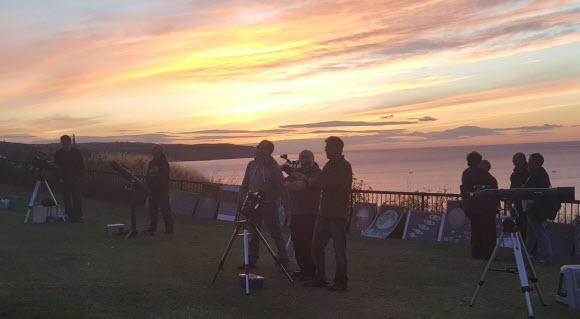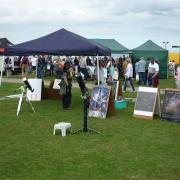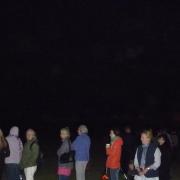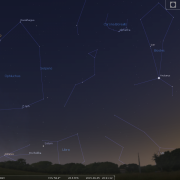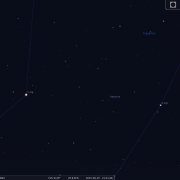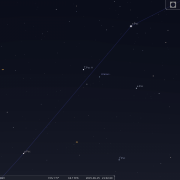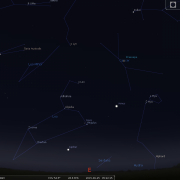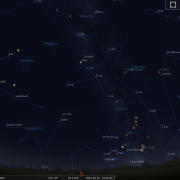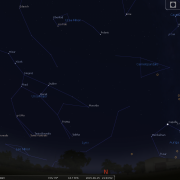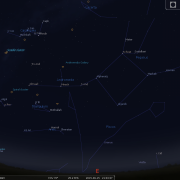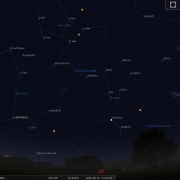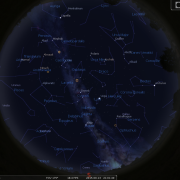Welcome to the WDAS monthly newsletter for September 2015: a digest of the month's latest contributions to our website. Below you'll find Society News, Sky Notes and In-Focus articles printed in full. There's also future events, and trailers for other articles which appear in full on the website - just a click away!
On the website you'll also be able to comment on articles, and if you'd like to play an editorial role in creating new content, just let us know!
Quick Summary for September:
- Among the star parties for September: a trip over to Westerdale our second visit of the summer to Hook's House Farm in Robin Hood's Bay.
- Total Lunar Eclipse on 28th Sepember.
August Star Party Season (photo by Warren). Click for full-size. More pictures in the Gallery.
Society News
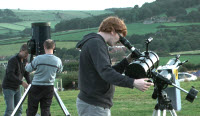
1st 2015 visit to Hook's House:
Sausage rolls, scale solar system
and some star viewing against the
backdrop of a lightning show.
Certainly one of our observing highlights on the WDAS calendar, the first of our two visits to Hooks House this proved to be an interesting affair.
I believe it was Wellington, who after Waterloo commented that the battle was ‘a dam close run thing’ The same could apply to the state and proximity of the weather and thunder storms on Saturday 22nd.
Although appearing ominous, luckily for us the storms slid just to north and west of Whitby, pushed away by a helpful southeasterly breeze. Not a drop of rain fell, but the light show teesside way was quite spectacular. Its a few years since a star party has gone ahead in such circumstances, but we rode our luck (good judgment) and eventually the sky cleared enough for a worthwhile star party.
Four scopes manned by Andi, Kieth, Lee and Mark were kept busy throughout the later evening, with more than enough present to help with the scale solar system.
Campers also enjoyed sausage rolls, Frankfurters and cheese on cocktail sticks, (Andi and Mark had been busy in the kitchen) All went down well (literally) the only down side was the reluctance of the moon and Saturn to escape the cloud over in the west, but we shouldn’t grumble, the campers certainly didn’t. The next event at Hooks House will be on Sept 5th, 8pm start.
 We shall once again be travelling over to Westerdale to host a star party on Saturday Sept 19th.
We shall once again be travelling over to Westerdale to host a star party on Saturday Sept 19th.
The venue will be the village hall / car park area within the village. Start time is 20:00h for the public, but will members wishing to attend (contact Mark) be there for 19:30-19:45h to allow time for equipment to be set up.
Anyone who has been before will know the site is reasonably dark and the natives are always friendly, and it will be nice to see our friend John. Hopefully the sky will be clear, but if not plan B will be initiated.
For once the weather behaved itself for the annual Perseid meteor shower with clear skies all round for much of the night.
The route to the Archery Green - our usual venue for this star party - deviated from the norm with access onto the field blocked by a locked bollard. This was expected, but a cunning alternative parking location meant that the equipment only had to carried 30 or 40 meters from the side of the ‘pitch and putt’ anyway.
The event itself proved to be better than average with regard to actual numbers of Perseids spotted. People were delighted to catch a glimpse or fully observe several bright examples before skies were even fully dark.
A sighting the the ISS caused some excitement, bang on predicted time.
By 23:30h nearly all had drifted away, but Andi, Andy, John L, Mark and Warren stayed on a while and saw some real corkers: one brilliant Perseid left an ionized trail which was visible for several seconds afterwards.
Around midnight almost one a minute was spotted, so the overall number seen whilst there must have been over 40, possibly 50 in a 2-3 hours observing session. Not at all bad!
After last year’s gales and torrential downpours, conditions this year were on the whole rather benign. Stubborn cloud banks during the Saturday afternoon solar viewing prevented prolonged observations, although during cloud breaks tantalizing glimpses of a sunspot grouping at least raised hopes of better views the following afternoon. Our location, behind the Owl sanctuary pen and adjacent to Grovers optics was certainly convenient for unloading and loading all the equipment. Limited, observations may have been, but there was still considerable interest with large crowds on the West cliff and a large oil pipe laying vessel laid off shore ensuring that the scopes were not idle.
Saturday night was in many ways similar to the Perseid party, less meteors of course, but with clear skies and a chill in the air. Because of the food fair marquees on Archery green, the raised pitch and putt area again served as our ‘observational base’. Saturn was the first target low in the SW, the rings and Titan delighting those present. As darkness fell the transparent skies yielded some great views of deep sky objects, our usual favourites. The ISS also made a pass and even the Oil pipe vessel ‘lit up like a city’ was a spectacle. Quite a decent evening was the consensus of opinion.
The Sunday solar observation event proved to be more satisfactory than the previous day, with quite lengthy sunny spells, the threatening cloud banks mostly keeping to the west.
Careful scrutiny of the solar disk revealed quite a rash of mostly faint sunspots. Business was quite brisk, although the owls didn’t seem to care a hoot.
Sunday night’s star party was hampered a little by fragmented cloud, although it was actually better attended by the public. As usual the scale solar system proved a hit. In the sky Saturn actually looked better than the night before, the image appearing more stable despite the low altitude.
Views of various deep sky objects, double stars et al, kept people more than interested. So, overall the Regatta events were quite successful, there have been better years, but considering all factors I think we didn’t do too badly at all.
A succession of star parties coinciding with the run up to the full moon were held on the west cliff at our usual location during Folk Week.
Fri 28-Aug-2015 (Folk Week) on West Cliff. (Photo by Warren)
Click image to see full-size, and click here to see more Star Party images in the gallery.
Skies were pretty clear and as always the folk week crowd were eager to view, stay and listen.
Thursday 27th proved interesting with a faint aurora visible to the north – a distinct green glow with a hint of rays and bands moving within this. It was a pity strong moonlight hampered observations, but all those present were overjoyed to witness even this, a real bonus then.
Business was brisk the following evening, although no aurora was visible, but everyone seemed quite satisfied with views of the moon, when it eventually showed its bright face through the muslin cloud cover in that part of the sky.
Thanks to all members who assisted over the course of the late August period, it makes the events more pleasurable.
Sky Notes
In this month's Sky Notes:
Planetary Skylights
 Saturn remains low in the South-Western twilight sky, the sole bright planet visible in the evening sky.
Saturn remains low in the South-Western twilight sky, the sole bright planet visible in the evening sky.
 There's a Total Lunar Eclipse in the early hours of 28th September. (See the article further down this page.)
There's a Total Lunar Eclipse in the early hours of 28th September. (See the article further down this page.)
 Neptune comes to opposition on Sept 1st when it lies due south at midnight and lies between the two naked eye stars of sigma and lambda Aquarii, but you will require a telescope to spot its tiny grey/blue disk.
Neptune comes to opposition on Sept 1st when it lies due south at midnight and lies between the two naked eye stars of sigma and lambda Aquarii, but you will require a telescope to spot its tiny grey/blue disk.
 Uranus lies in Pisces, low to the east but will be better placed next month. The minor planet Vesta comes to opposition on Sept 29th in Capricornus, upper right of its chief star Diphda.
Uranus lies in Pisces, low to the east but will be better placed next month. The minor planet Vesta comes to opposition on Sept 29th in Capricornus, upper right of its chief star Diphda.

 Venus and Mars reside in the dawn sky above the east horizon, and are joined by the waning crescent moon on the 10th. Venus cannot be mistaken, Mars appears ruddy in hue. Both are almost level with one another in the sky. Mars lies just above Regulus in Leo on the 24th/25th
Venus and Mars reside in the dawn sky above the east horizon, and are joined by the waning crescent moon on the 10th. Venus cannot be mistaken, Mars appears ruddy in hue. Both are almost level with one another in the sky. Mars lies just above Regulus in Leo on the 24th/25th
 Finally, Jupiter returns to the early morning sky, later in the month. Look for it below Venus and Mars. The three form a slanting line on the 25th.
Finally, Jupiter returns to the early morning sky, later in the month. Look for it below Venus and Mars. The three form a slanting line on the 25th.
Total Lunar Eclipse
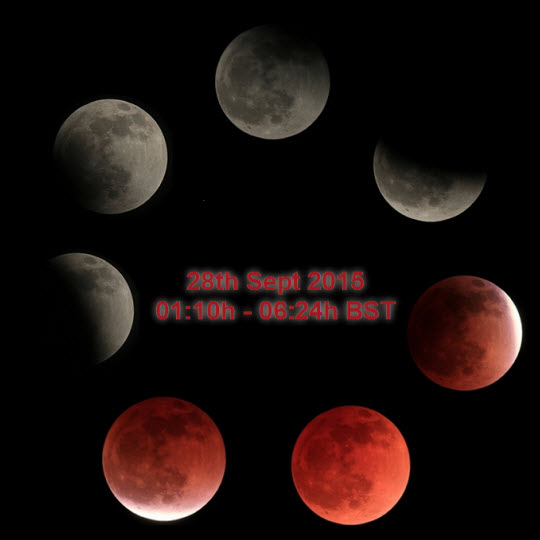
Undoubtedly the highlight this September will be a total Lunar Eclipse on the 28th. The downside being it occurs during the early morning hours.
If skies are clear however it will definitely be worth setting the alarm as the eclipse takes place when the moon is at Perigee, closest to the Earth in its orbit, so it will be a so called 'supermoon' eclipse, and will no doubt attract much media attention.
The initial part of the eclipse starts at 01:10h, but the noticeable umbral contact commences from 02:06h with totality beginning at 03:10h. Mid totality arrives at 03:47h with totality ending at 04:23h. The end of umbral contact is at 05:27h and the whole thing is over by 06:24h.
Meteor Activity

There are no major noteworthy meteor showers in September; however you may spot a few Piscids which have two peaks: the 8th and the 21st. Rates are low, only 6 or 7 per hour at best. As with all meteor showers early morning viewing will be best.
|
Looking South
Mid September - 21:00h |
Looking North |
|
Looking East
Mid September - 21:00h |
Looking West
Mid September - 21:00h |
|
|
|
|
Overview with Milky Way
Mid September - 21:00h |
|
Additional Image Credits:
- Planets and Comets where not otherwise mentioned: NASA
- Sky Charts: Stellarium Software
In-Focus
September is a great month for observing the night sky. Conditions are (or should be) relatively mild, darkness falls reasonably early and there are plenty of objects to seek out. September is also the best month to fully appreciate one particular feature of the heavens, the ghostly river of light we call the Milky Way.
To accomplish this however you must seek out a dark location, away from stray light and at a time when moonlight is absent. Once you have located your 'dark oasis' allow time for your eyes to become dark adapted before directing your gaze skywards, normally 10 -15 minutes should do.
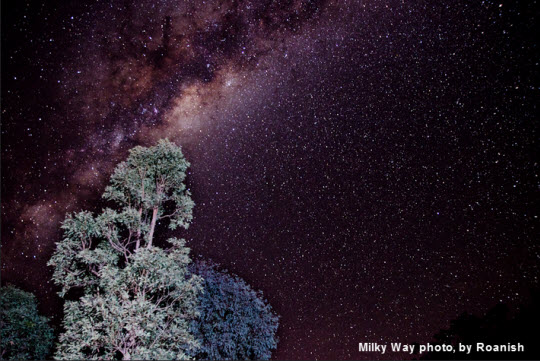
During September and early October the Milky Way dissects the sky from the NNE horizon, where it rises in Auriga, highlighted by scintillating Capella, before departing through Sagittarius straddling the SW horizon. In between, the Milky Way passes through Perseus, then the distinctive "W" pattern of Cassiopeia, where in binoculars a plethora of 'misty knots' are discernible. In larger instruments these resolve into glorious star fields and clusters. Moving through Cepheus, the Milky Way passes overhead directly through the long dimension of Cygnus the Swan (also known as the Northern Cross). Here, nearby its chief star Deneb the milky stream divides as though parted by a long sand bank midstream. Known as the 'northern rift', this island is actually a vast intervening dust cloud some 4000 light years distant and hundreds of light years in length that partly obscures the stellar multitude beyond. After Cygnus the Milky Way flows down through Aquila, passing bright Altair, before broadening its course through the constellation of Scutum, a small pattern rich in deep sky objects. The milky river then cascades down into Sagittarius, a constellation awash with nebulae and star clusters. Here amongst the celebrated star clouds of the Archer lies the centre of our galaxy.
Even today the sight of the Milky Way can be magical experience, but for thousands of year's ancient civilisations across the world revered its presence. To them it represented an overarching divine water course or spiritual path, guiding the soul of the departed into the afterlife. The true nature of this mystical ghostly light has been understood for over a century, a stellar citadel often depicted as a multi-armed spiral structure like a Catherine wheel on bonfire night. But in the last 5 years using data obtained from across the electromagnetic spectrum and from many varied sources, a clearer, more refined picture of our stellar metropolis has emerged.
Our galaxy is classed as a 'barred spiral' over 120,000 light years in diameter with just two major arms and two lesser ones. The central bar consists of stars orbiting in highly elliptical paths and is approximately 28,000 light years in length, bulging at the centre some 12,000 light years. Our own Sun is located on the edge of the 'Orion spur', a fairly quite stellar neighbourhood 26,000 light years from galactic centre and midway between two major arms, the nearest of which lies 6500 light years away. The arm's themselves are approximately 1500 light years thick. Once regarded as being the archetypal spiral galaxy; an isolated stellar island, observational studies reveal that our galaxy has cannibal tendencies, having absorbed several dwarf galaxies over the millennia. Astronomers believe that some of the many globular clusters visible are in fact the central cores of these. At the very heart of our galaxy lurks a black hole of some 4 million solar masses that 'feeds' on any star straying too close.
So when you next gaze up in awe at the Milky Way, remember, you are looking at the plane of our galaxy, the view we have of the spiral arms and galactic centre. Within his island universe, our Sun is just one of over 200 billion other stars around which orbit an estimated one trillion planets. How many other eyes i wonder gaze up at the majestic glow of our galaxy and contemplate other beings, it makes you think.
Image Credit:
- Milky Way taken by Roanish
Events
 Observe the night sky with us at the Bruce Observatory, Whitby School
Observe the night sky with us at the Bruce Observatory, Whitby School
Observing Nights are held weather permitting: check for a relatively clear sky before leaving home. If in doubt, Mark can be reached on 07886069339
Please note the college drive gate is now operated via a electronic key code - so anyone wishing to attend must be at the car park at the top of the drive by 19:00hrs - unless an arrival time has been arranged with Mark/Keith.
 Whitby School - Room H1.
Whitby School - Room H1.
In Members' monthly meetings we usually take a tour of the night sky for the coming month using the Planetarium program. Have talks and presentations on various topics of astronomy/space etc, and discuss future events etc. New members welcome.

